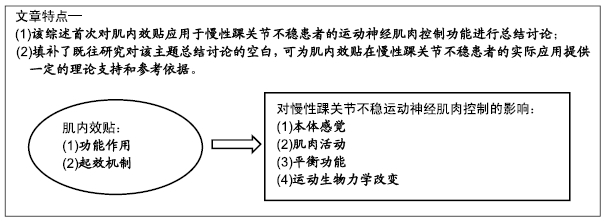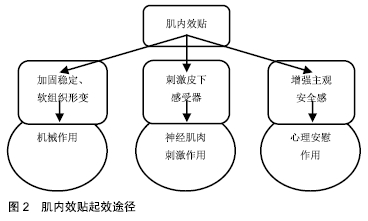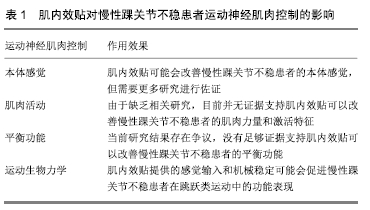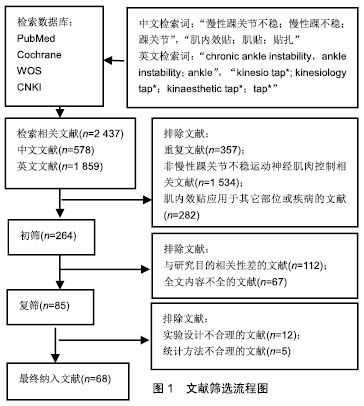[1] DOHERTY C, DELAHUNT E, CAULFIELD B, et al.The incidence and prevalence of ankle sprain injury: a systematic review and meta-analysis of prospective epidemiological studies.Sports Med. 2014;44 (1): 123-140.
[2] GRIBBLE PA, DELAHUNT E, BLEAKLEY CM, et al.Selection criteria for patients with chronic ankle instability in controlled research: a position statement of the International Ankle Consortium.J Athl Train.2014;49(1):121-127.
[3] VUURBERG G, HOORNTJE A, WINK LM, et al.Diagnosis, treatment and prevention of ankle sprains: update of an evidence- based clinical guideline.Br J Sports Med.2018;52(15):956.
[4] DOHERTY C, BLEAKLEY C, DELAHUNT E, et al. Treatment and prevention of acute and recurrent ankle sprain: an overview of systematic reviews with meta-analysis.Br J Sports Med.2017;51 (2): 113-125.
[5] KASE K, WALLIS J, KASE T.Clinical therapeutic applications of the kinesio taping method. 2nd ed. Tokyo: Ken Ikai Co.Ltd.2003.
[6] WANG CK, FANG YD, LIN LC, et al. Magnetic Resonance Elastography in the Assessment of Acute Effects of Kinesio Taping on Lumbar Paraspinal Muscles.J Magn Reson Imaging. 2018;49(4):1039-1045.
[7] YEUNG SS, YEUNG EW. Acute Effects of Kinesio Taping on Knee Extensor Peak Torque and Stretch Reflex in Healthy Adults. Medicine (Baltimore).2016; 95 (4): e2615.
[8] JUNG HG, KIM NR, KIM TH, et al. Magnetic Resonance Imaging and Stress Radiography in Chronic Lateral Ankle Instability.Foot Ankle Int.2017;38(6):621-626.
[9] 覃华生,潘玮敏,李然,等.慢性踝关节不稳的运动康复:研究现状与特点[J].中国组织工程研究,2018,22(36):5865-5871.
[10] KOSIK KB, MCCANN RS,TERADA M, et al. Therapeutic interventions for improving self-reported function in patients with chronic ankle instability: a systematic review.Br J Sports Med.2017;51 (2): 105-112.
[11] 罗炯,郑兵,解浩东.肌内效贴扎对足踝生物力学特征影响的理论研究与应用进展[J].中国组织工程研究, 2017,21(28):4570-4576.
[12] 余波,祁奇,陈文华,等.不同贴扎方式肌内效贴的回缩力特征及其改变皮下间隙的临床研究[J].中国康复医学杂志, 2016,31(3): 296-300.
[13] SIMON J, GARCIA W, DOCHERTY CL.The effect of kinesio tape on force sense in people with functional ankle instability.Clin J Sport Med.2014;24 (4): 289-294.
[14] RAHLF AL, BRAUMANN KM, ZECH A.Kinesio taping improves perceptions of pain and function of patients with knee osteoarthritis. a randomized, controlled trial.J Sport Rehabil.2018; 28(5):481-487.
[15] YOOSEFINEJAD AK, MOTEALLEH A, ABBASALIPUR S, et al. Can inhibitory and facilitatory kinesiotaping techniques affect motor neuron excitability? A randomized cross-over trial.J Bodyw Mov Ther.2017; 21 (2): 234-239.
[16] PAMUK U, YUCESOY CA.MRI analyses show that kinesio taping affects much more than just the targeted superficial tissues and causes heterogeneous deformations within the whole limb.J Biomech. 2015;48(16):4262-4270.
[17] CIMINO SR, BEAUDETTE SM, BROWN SHM. Kinesio taping influences the mechanical behaviour of the skin of the low back: A possible pathway for functionally relevant effects.J Biomech.2018; 67:150-156.
[18] KONISHI Y.Tactile stimulation with kinesiology tape alleviates muscle weakness attributable to attenuation of Ia afferents.J Sci Med Sport.2013;16(1):45-48.
[19] TREMBLAY F, KARAM S.Kinesio-Taping Application and Corticospinal Excitability at the Ankle Joint.J Athl Train.2015;50 (8): 840-846.
[20] DE-LA-TORRE-DOMINGO C, ALGUACIL-DIEGO I M, MOLINA-RUEDA F, et al. Effect of kinesiology tape on measurements of balance in subjects with chronic ankle instability: a randomized controlled trial.Arch Phys Med Rehabil.2015;96 (12): 2169-2175.
[21] WU X, SONG W, ZHENG C, et al.Morphological study of mechanoreceptors in collateral ligaments of the ankle joint.J Orthop Surg Res.2015;10:92.
[22] HAGEN M, LEMKE M, LAHNER M. Deficits in subtalar pronation and supination proprioception in subjects with chronic ankle instability.Hum Mov Sci.2018;57:324-331.
[23] BOYLE J, NEGUS V.Joint position sense in the recurrently sprained ankle.Aust J Physiother.1998; 44 (3): 159-163.
[24] YOKOYAMA S,MATSUSAKA N,GAMADA K, et al. Position- specific deficit of joint position sense in ankles with chronic functional instability.J Sports Sci Med.2008;7(4):480-485.
[25] ARNOLD BL, DOCHERTY CL.Low-load eversion force sense, self-reported ankle instability, and frequency of giving way.J Athl Train.2006;41(3):233-238.
[26] SOUSA ASP, LEITE J, COSTA B, et al.Bilateral Proprioceptive Evaluation in Individuals With Unilateral Chronic Ankle Instability.J Athl Train.2017;52(4):360-367.
[27] KONRADSEN L. Factors Contributing to Chronic Ankle Instability: Kinesthesia and Joint Position Sense.J Athl Train.2002;37(4): 381-385.
[28] HERTEL J.Sensorimotor deficits with ankle sprains and chronic ankle instability.Clin Sports Med.2008;27(3):353-370.
[29] HALSETH T, MCCHESNEY J, DEBELISO M, et al. The effects of kinesio™ taping on proprioception at the ankle.J Sports Sci Med. 2004;3(1):1-7.
[30] BAILEY D, FIRTH P. Does kinesiology taping of the ankles affect proprioceptive control in professional football (soccer) players? Phys Ther Sport.2017;25:94-98.
[31] LONG Z, WANG R, HAN J, et al. Optimizing ankle performance when taped: Effects of kinesiology and athletic taping on proprioception in full weight-bearing stance.J Sci Med Sport.2017; 20(3):236-240.
[32] WISTHOFF B,MATHENY S,STRUMINGER A, et al. Ankle Strength Deficits in a Cohort of Collegiate Athletes with Chronic Ankle Instability.J Sport Rehabil.2019;19:1-6.
[33] MUNN J,BEARD DJ,REFSHAUGE KM, et al. Eccentric muscle strength in functional ankle instability. [J]Med Sci Sports Exerc.2003;35 (2): 245-250.
[34] MCCANN RS,BOLDING BA,TERADA M,et al.Isometric Hip Strength and Dynamic Stability of Individuals With Chronic Ankle Instability.J Athl Train.2018;53 (7): 672-678.
[35] CSAPO R,ALEGRE LM. Effects of kinesio (R) taping on skeletal muscle strength-a meta-analysis of current evidence.J Sci Med Sport.2015;18 (4): 450-456.
[36] YEUNG SS, YEUNG EW.Acute Effects of Kinesio Taping on Knee Extensor Peak Torque and Stretch Reflex in Healthy Adults. Medicine(Baltimore).2016;95 (4): e2615.
[37] KAYA MUTLU E,MUSTAFAOGLU R,BIRINCI T, et al. Does Kinesio Taping of the Knee Improve Pain and Functionality in Patients with Knee Osteoarthritis? Am J Phys Med Rehabil.2017;96 (1): 25-33.
[38] LEMOS TV,JUNIOR JRS,SANTOS M, et al.Kinesio Taping effects with different directions and tensions on strength and range of movement of the knee: a randomized controlled trial.Braz J Phys Ther.2018;22 (4): 283-290.
[39] LINS CA,BORGES DT,MACEDO LB,et al.Delayed effect of Kinesio Taping on neuromuscular performance, balance, and lower limb function in healthy individuals: a randomized controlled trial. Braz J Phys Ther.2016;20 (3): 231-239.
[40] KORMAN P, STRABURZYŃSKA-LUPA A, RUTKOWSKI R, et al.Kinesio taping does not alter quadriceps isokinetic strength and power in healthy nonathletic men: a prospective crossover study.Biomed Res Int,2015:626257.
[41] CSAPO R,HERCEG M,ALEGRE LM, et al.Do kinaesthetic tapes affect plantarflexor muscle performance? J Sports Sci.2012;30 (14): 1513-1519.
[42] GÓMEZ-SORIANO J,ABIÁN-VICÉN J,APARICIO-GARCÍA C, et al. The effects of Kinesio taping on muscle tone in healthy subjects: A double-blind, placebo-controlled crossover trial.Man Ther.2014;19 (2): 131-136.
[43] YAM ML,YANG Z,ZEE BC, et al.Effects of Kinesio tape on lower limb muscle strength, hop test, and vertical jump performances: a meta-analysis.BMC Musculoskelet Disord.2019;20 (1): 212.
[44] FEGER MA,DONOVAN L,HART J M, et al.Lower extremity muscle activation in patients with or without chronic ankle instability during walking.J Athl Train.2015;50 (4): 350-357.
[45] LIN CF,CHEN CY,LIN CW. Dynamic ankle control in athletes with ankle instability during sports maneuvers.Am J Sports Med.2011;39 (9): 2007-2015.
[46] SOUSA ASP,VALENTE I,PINTO A,et al.Short and Medium Latency Responses in Participants With Chronic Ankle Instability.J Athl Train.2018;53 (7): 679-686.
[47] FAYSON SD,NEEDLE AR,KAMINSKI TW.The Effect of Ankle Kinesio Tape on Ankle Muscle Activity During a Drop Landing.J Sport Rehabil.2015;24 (4): 391-397.
[48] MARTINEZ-GRAMAGE J,MERINO-RAMIREZ MA,AMER-CUENCA JJ,et al.Effect of Kinesio Taping on gastrocnemius activity and ankle range of movement during gait in healthy adults: A randomized controlled trial.Phys Ther Sport.2016;18:56-61.
[49] BRIEM K,EYTHÖRSDÖTTIR H,Magnúsdóttir RG,et al.Effects of kinesio tape compared with nonelastic sports tape and the untaped ankle during a sudden inversion perturbation in male athletes.J Orthop Sports Phys Ther.2011;41 (5): 328-335.
[50] WIKSTROM EA,FOURNIER KA,MCKEON PO.Postural control differs between those with and without chronic ankle instability.Gait Posture.2010;32 (1): 82-86.
[51] TERADA M, BEARD M, CAREY S, et al.nonlinear dynamic measures for evaluating postural control in individuals with and without chronic ankle Instability.Motor Control.2019;23(2): 243-261.
[52] DOHERTY C, BLEAKLEY C, HERTEL J, et al.Dynamic balance deficits in individuals with chronic ankle instability compared to ankle sprain copers 1 year after a first-time lateral ankle sprain injury.Knee Surg Sports Traumatol Arthrosc.2016;24(4): 1086-1095.
[53] FUSCO A,GIANCOTTI GF,FUCHS PX, et al. Wobble board balance assessment in subjects with chronic ankle instability.Gait Posture.2019;68:352-356.
[54] HOCH MC, GAVEN SL, WEINHANDL JT. Kinematic predictors of star excursion balance test performance in individuals with chronic ankle instability.Clin Biomech (Bristol, Avon).2016;35:37-41.
[55] HOLMES A, DELAHUNT E.Treatment of common deficits associated with chronic ankle instability.Sports Med.2009;39(3): 207-224.
[56] ANDREO P, KHALAF K, HEALE L, et al. Effects of Kinesiology Tape on Non-linear Center of Mass Dispersion During the Y Balance Test.Front Physiol.2018;9:1527.
[57] NAKAJIMA MA, BALDRIDGE C.The effect of kinesio tape on vertical jump and dynamic postural control.Int J Sports Phys Ther.2013; 8 (4): 393–406.
[58] JACKSON K, SIMON JE, DOCHERTY CL. Extended use of kinesiology tape and balance in participants with chronic ankle instability.J Athl Train.2016;51(1):16-21.
[59] LEE BG, LEE JH.Immediate effects of ankle balance taping with kinesiology tape on the dynamic balance of young players with functional ankle instability.Technol Health Care.2015;23(3): 333-341.
[60] BICICI S, KARATAS N, BALTACI G. Effect of athletic taping and kinesiotaping on measurements of functional performance in basketball players with chronic inversion ankle sprains.Int J Sports Phys Ther.2012;7 (2): 154-166.
[61] SHIELDS CA, NEEDLE AR, ROSE WC, et al.Effect of elastic taping on postural control deficits in subjects with healthy ankles, copers, and individuals with functional ankle instability.Foot Ankle Int.2013;34 (10): 1427-1435.
[62] MOISAN G, DESCARREAUX M, CANTIN V. Effects of chronic ankle instability on kinetics, kinematics and muscle activity during walking and running: A systematic review.Gait Posture.2017;52: 381-399.
[63] BIGOUETTE J, SIMON J, LIU K, et al. Altered vertical ground reaction forces in participants with chronic ankle instability while running.J Athl Train.2016;51 (9): 682-687.
[64] NYSKA M, SHABAT S, SIMKIN A, et al. Dynamic force distribution during level walking under the feet of patients with chronic ankle instability.Br J Sports Med.2003;37(6):495-497.
[65] YEN SC, CHUI KK, CORKERY MB, et al.Hip-ankle coordination during gait in individuals with chronic ankle instability.Gait Posture.2017;53:193-200.
[66] KIM H, SON SJ, SEELEY MK, et al. Kinetic Compensations due to Chronic Ankle Instability during Landing and Jumping.Med Sci Sports Exerc.2018;50(2):308-317.
[67] BOOZARI S, SANJARI MA, AMIRI A, et al. Effect of Gastrocnemius Kinesio Taping on Countermovement Jump Performance and Vertical Stiffness Following Muscle Fatigue.J Sport Rehabil.2018; 27 (4): 306-311.
[68] WANG Y, GU Y, CHEN J, et al. Kinesio taping is superior to other taping methods in ankle functional performance improvement: a systematic review and meta-analysis.Clin Rehabil.2018;32 (11): 1472-1481.
[69] HUANG CY, HSIEH TH, LU SC, et al.Effect of the Kinesio tape to muscle activity and vertical jump performance in healthy inactive people.Biomed Eng Online.2011;10:70.
|




